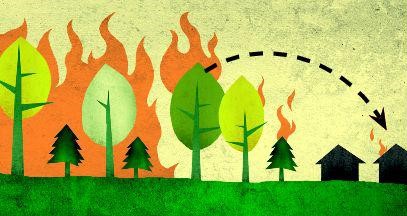Protecting Your Home
Protect Your Home from Wildfire

In September of 2014 hundreds of Corvallis residents experienced a wildfire up close. As wildfires go, it was not catastrophic – an 86-acre “brush fire” causing limited damage and no injuries – but many Timberhill area structures could have been damaged or lost.
We could easily see how quickly the fire spread and the number of fire personnel required to suppress it. Response from 17 fire agencies in Benton and four adjacent counties was swift and effective. However, we would be mistaken to assume that successful suppression of the Timberhill Fire means that we will be safe from wildfire threat in the future.
Now is the time to protect your home and family from wildfire!
We learned that wildfire does happen here. In fact, wildfires occur each year in Benton County and fortunately they are extinguished promptly. National estimates place the number of wildfires escaping suppression at about 2 percent and local fire professionals repeatedly remind us “It’s not if, but when” such fires might occur. Our time will come. When it does, will we be prepared?
Embers Cause Home Ignitions
Imagine the Timberhill Fire further from town, in an area with no fire hydrants, narrow roads, sloping terrain and homes surrounded by forest vegetation. This description fits most of rural Benton County. Unlike the grass and brush of the Timberhill Fire, when trees and heavier vegetation burn, embers (burning chunks of wood) are lofted into the air, where they can travel more than a mile. Embers are the primary cause of home ignitions during wildfire. Even when the flames are too distant to be seen, entire homes can be consumed by fires sparked by an ember landing in a bed of fuels.
What Are Fuels?
Fuels include any materials that can combust during a wildfire such as dry grass, pine needles, last year’s leaves, stacked firewood, shrubs, trees, fences, lawn furniture, decks and even houses! A few inches of pine needles in a gutter are a highly flammable fuel that, when ignited, can produce a flame length of 18 inches – enough to set a home ablaze. During a wildfire, when ember storms carry burning debris through neighborhoods, something as simple as dry leaves beneath a wood deck can trigger a sequence that leads to the loss of a home.
Reduce Fuels – Create Defensible Space!
Visualize a wildfire scenario with a few – or even dozens of – homes on fire surrounded by burning forest fuels. Add to this picture the dry and windy conditions of late summer in Benton County. How long would it take for professional firefighters become overwhelmed? In similar situations across the nation, personal homeowner responsibility for creating defensible space has been a key factor in saving thousands of homes from wildfire.
Understanding that wildfire will occur here and that embers are the primary cause of home losses, what can residents do? Create defensible space – and keep it lean, green and clean. Defensible space breaks up the continuous path of vegetation that could carry wildfire to a home. It also gives firefighters a safe zone from which to fight a wildfire.
For expert assistance evaluating a home and property for wildfire risk, those interested can contact Oregon Department of Forestry Community Wildfire Forester at 541-929-9165.
Things to do to be prepared
- Clear leaves and other debris from gutters, eaves, porches and decks. This prevents embers from igniting your home.
- Remove dead vegetation and other items from under your deck or porch, and within 10 feet of the house.
- Screen or box-in areas below patios and decks with wire mesh to prevent debris and combustible materials from accumulating.
- Remove flammable materials (firewood stacks, propane tanks) within 30 feet of your home’s foundation and outbuildings, including garages and sheds. If it can catch fire, don’t let it touch your house, deck or porch.
- Wildfire can spread to tree tops. Prune trees so the lowest branches are 6 to 10 feet from the ground.
- Keep your lawn hydrated and maintained. If it is brown, cut it down to reduce fire intensity. Dry grass and shrubs are fuel for wildfire.
- Don’t let debris and lawn cuttings linger. Dispose of these items quickly to reduce fuel for fire.
- Inspect shingles or roof tiles. Replace or repair those that are loose or missing to prevent ember penetration.
- Cover exterior attic vents with metal wire mesh no larger than 1/8 inch to prevent sparks from entering the home.
- Enclose under-eave and soffit vents or screens with metal mesh to prevent ember entry.
